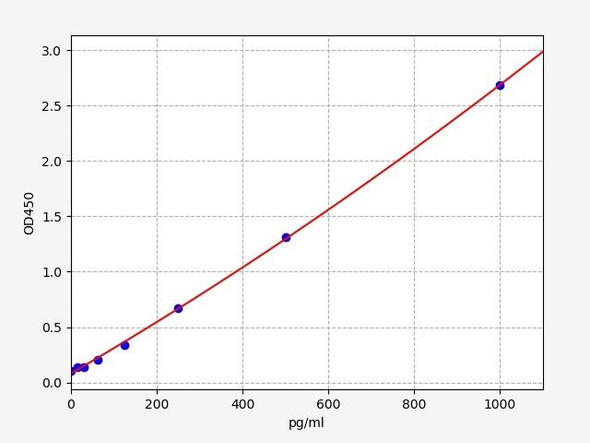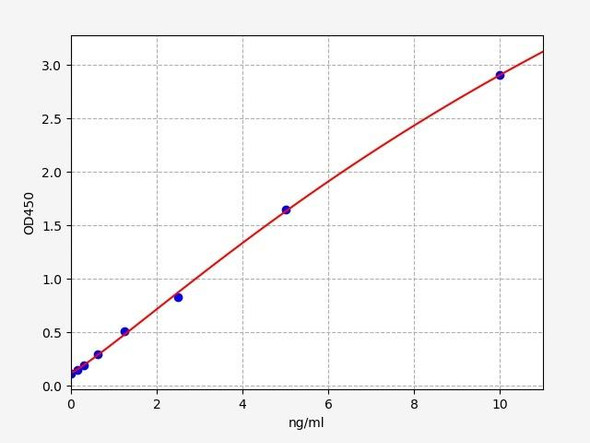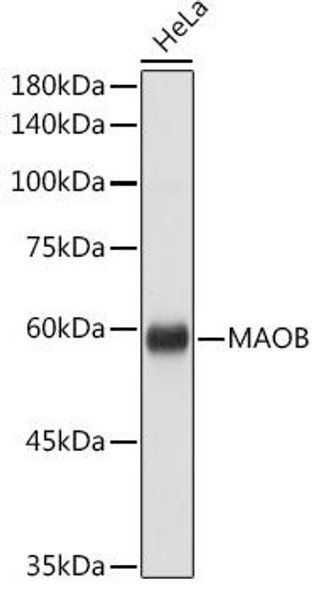Rat MAOB / Monoamine Oxidase B ELISA Kit (RTFI00549)
- SKU:
- RTFI00549
- Product Type:
- ELISA Kit
- Size:
- 96 Assays
- Uniprot:
- P19643
- Sensitivity:
- 46.875pg/ml
- Range:
- 78.125-5000pg/ml
- ELISA Type:
- Sandwich
- Synonyms:
- Maob, Monoamine oxidase type B, MAO-B
- Reactivity:
- Rat
Description
Rat MAOB/Monoamine Oxidase B ELISA Kit
The Rat MAOB (Monoamine Oxidase B) ELISA Kit is a powerful tool for researchers seeking to accurately measure MAOB levels in rat samples. With its high sensitivity and specificity, this kit provides reliable and reproducible results, making it suitable for a variety of research applications.MAOB is an enzyme that plays a key role in the metabolism of neurotransmitters such as dopamine and serotonin. Dysregulation of MAOB activity has been linked to neurological disorders such as Parkinson's disease and depression, making it an important target for research and drug development.
By using the Rat MAOB ELISA Kit, researchers can gain valuable insights into the role of MAOB in disease pathogenesis and explore potential therapeutic interventions. With its easy-to-use format and high performance, this kit is a valuable asset for any laboratory studying the complex interplay of neurotransmitters in health and disease.
| Product Name: | Rat Maob (Amine oxidase [flavin-containing] B) ELISA Kit |
| Product Code: | RTFI00549 |
| Size: | 96 Assays |
| Target: | Rat Maob |
| Alias: | Maob, Monoamine oxidase type B, MAO-B |
| Reactivity: | Rat |
| Detection Method: | Sandwich ELISA, Double Antibody |
| Sensitivity: | 46.875pg/ml |
| Range: | 78.125-5000pg/ml |
| Storage: | 4°C for 6 months |
| Note: | For Research Use Only |
| Recovery: | Matrices listed below were spiked with certain level of Rat Maob and the recovery rates were calculated by comparing the measured value to the expected amount of Rat Maob in samples. | ||||||||||||||||
| |||||||||||||||||
| Linearity: | The linearity of the kit was assayed by testing samples spiked with appropriate concentration of Rat Maob and their serial dilutions. The results were demonstrated by the percentage of calculated concentration to the expected. | ||||||||||||||||
| |||||||||||||||||
| Intra-Assay: | CV <8% | ||||||||||||||||
| Inter-Assay: | CV <10% |
| Uniprot: | P19643 |
| UniProt Protein Function: | MAOB: Catalyzes the oxidative deamination of biogenic and xenobiotic amines and has important functions in the metabolism of neuroactive and vasoactive amines in the central nervous system and peripheral tissues. MAOB preferentially degrades benzylamine and phenylethylamine. Belongs to the flavin monoamine oxidase family. |
| UniProt Protein Details: | Protein type:Membrane protein, integral; Mitochondrial; Oxidoreductase; EC 1.4.3.4; Amino Acid Metabolism - histidine; Amino Acid Metabolism - phenylalanine; Amino Acid Metabolism - glycine, serine and threonine; Amino Acid Metabolism - tryptophan; Xenobiotic Metabolism - drug metabolism - cytochrome P450; Amino Acid Metabolism - tyrosine; Amino Acid Metabolism - arginine and proline Cellular Component: mitochondrial outer membrane; mitochondrion; mitochondrial inner membrane; integral to membrane Molecular Function:amine oxidase activity; protein homodimerization activity; FAD binding; oxidoreductase activity Biological Process: response to drug; positive regulation of dopamine metabolic process; negative regulation of serotonin secretion; response to selenium ion; response to ethanol; neurotransmitter catabolic process; substantia nigra development; response to steroid hormone stimulus; response to toxin; response to lipopolysaccharide; response to aluminum ion; response to corticosterone stimulus |
| NCBI Summary: | major neurotransmitter-degrading enzyme in the CNS; degrades biogenic monoamines in the brain [RGD, Feb 2006] |
| UniProt Code: | P19643 |
| NCBI GenInfo Identifier: | 6981180 |
| NCBI Gene ID: | 25750 |
| NCBI Accession: | NP_037330.1 |
| UniProt Secondary Accession: | P19643,Q5EBB5, |
| UniProt Related Accession: | P19643 |
| Molecular Weight: | 58,459 Da |
| NCBI Full Name: | amine oxidase |
| NCBI Synonym Full Names: | monoamine oxidase B |
| NCBI Official Symbol: | Maob |
| NCBI Protein Information: | amine oxidase [flavin-containing] B; amine oxidase [flavin-containing] B; MAO-B; monoamine oxidase-B; monoamine oxidase type B |
| UniProt Protein Name: | Amine oxidase [flavin-containing] B |
| UniProt Synonym Protein Names: | Monoamine oxidase type B; MAO-B |
| Protein Family: | Amine oxidase |
| UniProt Gene Name: | Maob |
| UniProt Entry Name: | AOFB_RAT |
| Step | Procedure |
| 1. | Set standard, test sample and control (zero) wells on the pre-coated plate respectively, and then, record their positions. It is recommended to measure each standard and sample in duplicate. Wash plate 2 times before adding standard, sample and control (zero) wells! |
| 2. | Aliquot 0.1ml standard solutions into the standard wells. |
| 3. | Add 0.1 ml of Sample / Standard dilution buffer into the control (zero) well. |
| 4. | Add 0.1 ml of properly diluted sample ( Human serum, plasma, tissue homogenates and other biological fluids.) into test sample wells. |
| 5. | Seal the plate with a cover and incubate at 37°C for 90 min. |
| 6. | Remove the cover and discard the plate content, clap the plate on the absorbent filter papers or other absorbent material. Do NOT let the wells completely dry at any time. Wash plate X2. |
| 7. | Add 0.1 ml of Biotin- detection antibody working solution into the above wells (standard, test sample & zero wells). Add the solution at the bottom of each well without touching the side wall. |
| 8. | Seal the plate with a cover and incubate at 37°C for 60 min. |
| 9. | Remove the cover, and wash plate 3 times with Wash buffer. Let wash buffer rest in wells for 1 min between each wash. |
| 10. | Add 0.1 ml of SABC working solution into each well, cover the plate and incubate at 37°C for 30 min. |
| 11. | Remove the cover and wash plate 5 times with Wash buffer, and each time let the wash buffer stay in the wells for 1-2 min. |
| 12. | Add 90 µL of TMB substrate into each well, cover the plate and incubate at 37°C in dark within 10-20 min. (Note: This incubation time is for reference use only, the optimal time should be determined by end user.) And the shades of blue can be seen in the first 3-4 wells (with most concentrated standard solutions), the other wells show no obvious color. |
| 13. | Add 50 µL of Stop solution into each well and mix thoroughly. The color changes into yellow immediately. |
| 14. | Read the O.D. absorbance at 450 nm in a microplate reader immediately after adding the stop solution. |
When carrying out an ELISA assay it is important to prepare your samples in order to achieve the best possible results. Below we have a list of procedures for the preparation of samples for different sample types.
| Sample Type | Protocol |
| Serum: | If using serum separator tubes, allow samples to clot for 30 minutes at room temperature. Centrifuge for 10 minutes at 1,000x g. Collect the serum fraction and assay promptly or aliquot and store the samples at -80°C. Avoid multiple freeze-thaw cycles. If serum separator tubes are not being used, allow samples to clotovernight at 2-8°C. Centrifuge for 10 minutes at 1,000x g. Removeserum and assay promptly or aliquot and store the samples at-80°C. Avoid multiple freeze-thaw cycles. |
| Plasma: | Collect plasma using EDTA or heparin as an anti-coagulant. Centrifuge samples at 4°C for 15 mins at 1000 × g within 30 mins of collection. Collect the plasma fraction and assay promptly or aliquot and store the samples at -80°C. Avoid multiple freeze-thaw cycles.Note: Over haemolysed samples are not suitable for use with this kit. |
| Urine & Cerebrospinal Fluid: | Collect the urine (mid-stream) in a sterile container, centrifuge for 20 mins at 2000-3000 rpm. Remove supernatant and assay immediately. If any precipitation is detected, repeat the centrifugation step. A similar protocol can be used for cerebrospinal fluid. |
| Cell Culture Supernatant: | Collect the cell culture media by pipette, followed by centrifugation at 4°C for 20 mins at 1500 rpm. Collect the clear supernatant and assay immediately. |
| Cell Lysates: | Solubilize cells in lysis buffer and allow to sit on ice for 30 minutes. Centrifuge tubes at 14,000 x g for 5 minutes to remove insoluble material. Aliquot the supernatant into a new tube and discard the remaining whole cell extract. Quantify total protein concentration using a total protein assay. Assay immediately or aliquot and store at ≤ -20°C. |
| Tissue Homogenates: | The preparation of tissue homogenates will vary depending upon tissue type. Rinse tissue with 1X PBS to remove excess blood & homogenizein 20ml of 1X PBS (including protease inhibitors) and store overnight at ≤ -20°C. Two freeze-thaw cycles are required to break the cell membranes. To further disrupt the cell membranes you can sonicate the samples. Centrifuge homogenates for 5 mins at 5000xg. Remove the supernatant and assay immediately or aliquot and store at -20°C or-80°C. |
| Tissue Lysates: | Rinse tissue with PBS, cut into 1-2 mm pieces, and homogenize with a tissue homogenizer in PBS. Add an equal volume of RIPA buffer containing protease inhibitors and lyse tissues at room temperature for 30 minutes with gentle agitation. Centrifuge to remove debris. Quantify total protein concentration using a total protein assay. Assay immediately or aliquot and store at ≤ -20 °C. |
| Breast Milk: | Collect milk samples and centrifuge at 10,000 x g for 60 min at 4°C. Aliquot the supernatant and assay. For long term use, store samples at -80°C. Minimize freeze/thaw cycles. |






